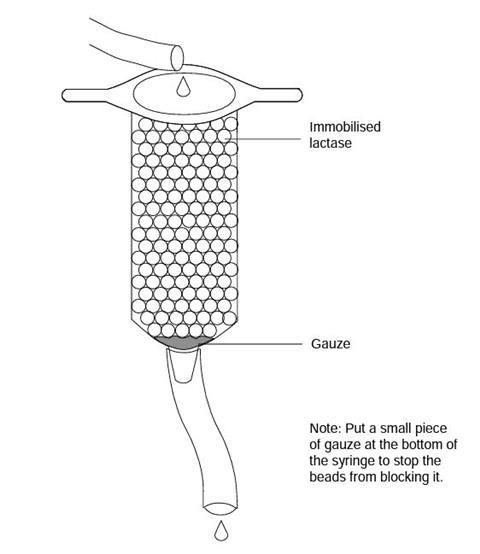Science can be cheesy, but never more so than this experiment into cheese making enzymes
This experiment should take one hour, with an additional hour for the extension.
Equipment
Materials per group
- Whole pasteurised milk (‘silver top’), 40 cm3
- Rennet essence (of bovine origin, containing both chymosin and pepsin), 1 cm3
- ‘Maxiren’ (pure chymosin) from genetically engineered yeast, 1 cm3
- ’Rennilase’ (microbial protease) from a fungus, 1 cm3
- Deionised water, 1 cm3
For the Extension
Making a sweet syrup from the whey
- Lactase enzyme (Novo ‘Lactozym®’), 2 cm3
- Sodium alginate solution (Note: sodium alginate is not readily soluble and requires both warm water and stirring to dissolve), 8 cm3 of a 2% (w/v)
- Calcium chloride solution, 100 cm3 of a 1.5% (w/v), DiastixTM (available from pharmacies) or other glucose detector
Equipment per group
- Plastic syringes without needles, 10 cm3
- Boiling tubes or sample bottles x 4
- Glass rods x 4
- Thermometer
- Stop-watch
- Access to water bath maintained at 37°C
- Safety glasses
For the extension
- Small piece (about 1 cm2) of nylon gauze eg net curtain
- Plastic syringe (without needle), 10 cm3
- 10 cm length of 4 mm diameter aquarium airline tubing to fit syringe
- Aquarium airline tap or adjustable laboratory tubing clip (Hoffman clip)
- Retort stand, boss and clamp
- Small beakers (ca 100 cm3) or disposable plastic cups, x 2
- Tea strainer
Health, safety and technical notes
- Read our standard health and safety guidance here.
- Wear eye protection.
- Wear clothing protection, if desired.
- This is an open-ended problem-solving activity, so the guidance given here is necessarily incomplete.
- Unnecessary contact with the enzyme or inhalation of dust from dried-up enzyme spills should be avoided.
- In case of spillage or contact with the eyes, rinse by flushing with water.
Commentary
On this occasion the students worked in groups of three and each group was given a box containing all the necessary apparatus. The practical details are adapted from a National Dairy Council Publication. If the extension is completed, this problem will fit well with ‘Any glucose?’.
Procedure
The aim of this experiment is to compare the milk-clotting abilities of the three enzymes.
The students should be able to design the experiment and appreciate that they may need to warm the milk to 37 °C. The formation of a precipitate may then be observed within 5 – 15 minutes.
It may be seen adhering to the sides of the tubes when they are gently rocked from side to side, or clinging to a glass rod dipped into the liquid. The activities of the three enzymes should be found to vary markedly.
Extension
You can extend the problem by investigating the activity of the enzymes at different temperatures and at different pH values.
Making a sweet syrup from the whey
Whey contains lactose, which can be split up by the enzyme lactase to the simpler sugars glucose and galactose. These sugars are sweet and are the basis of a syrup that is used widely in the food industry. An interesting extension is therefore to ask the students to make this sweet syrup, containing glucose, from the whey by using an immobilised enzyme column.
Practical details
The enzyme lactase converts the whey to a sweet syrup, and this enzyme can be immobilised by trapping it in calcium alginate beads. The beads are packed into a small column, over which the whey is passed. Instructions for setting up the column and treating the whey are given below.
Immobilising the lactase enzyme and packing the column
- Draw up 2 cm3 of enzyme in a syringe and transfer to a small beaker.
- Using the same syringe, transfer 8 cm3 of sodium alginate solution to the beaker and mix.
- Draw the mixed solution into the syringe.
- Pressing the plunger gently, add the mixture to the calcium chloride solution drop by drop.
- Strain the beads.
- Rinse with distilled water.
- Pack the beads into the column.
- Treat the whey by pouring it through the column. The syrup coming out of the syringe should be found to contain glucose.

Notes
- This resource is part of a collection of problem-solving activities, designed to engage learners in small group work. Find out how to use these resources, and obtain a list of suggested ‘junk items’ here.
- The tip of the syringe must not be allowed to come into contact with the calcium chloride solution. The immobilised enzyme beads should be allowed to harden for a few minutes before being separated from the liquid with a tea-strainer.
Downloads
From milk to curds and whey - which enzyme?
Experiment | PDF, Size 75.08 kb
Additional information
The resources were originally published in the book In Search of More Solutions.
This experiment was based on an idea contributed by Dean Madden and John Schollar of the National Centre for Biotechnology , who gave advice on the development of this activity and the experimental procedures described were developed in their laboratories.


















No comments yet